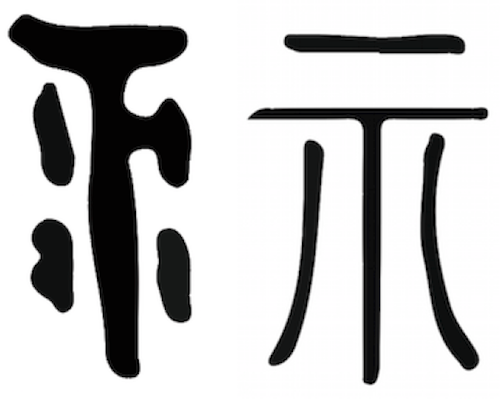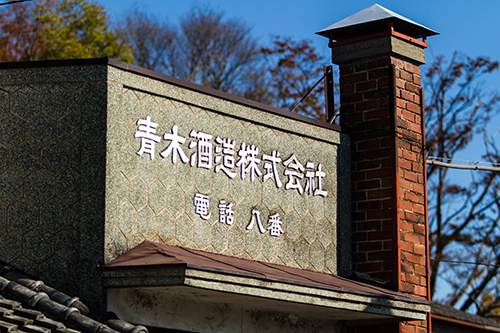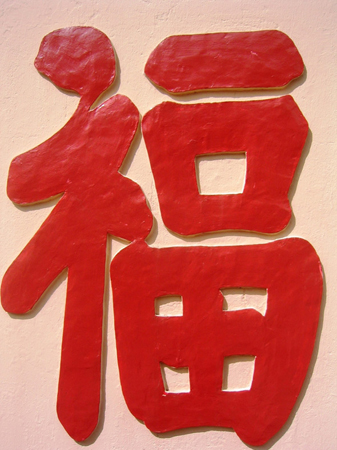113. The "Showing" Radical: 示 and 礻
To understand the "showing" radical 示, let's start with the autonomous kanji 示:
示 (695: to show, point out, display; instruct)
This character once had a slightly different shape, representing a primitive altar (T) with drops, perhaps of blood or of sacrificial wine. The ancient Chinese eventually added a horizontal stroke on top to indicate a sacrifice or item placed on the altar. With or without that flat line, the shape makes sense as an altar.
How ironic, then, that this kanji no longer means "altar"! It's gone through a secularization process.
Instead, the character 示 primarily means "to show," a definition that came from the idea that whatever resulted from a sacrifice showed the will of the gods. This etymological information comes from Henshall, as is true of all the etymologies in this Radical Note.

The left-hand image (an oracle-script version of 示) shows what Henshall describes, though he presents only two or three drops of liquid, and this picture shows four. We know that the right-hand image, a seal-script version of 示, represents a more-evolved character because it features the extra horizontal stroke on top. Both images are courtesy of Richard Sears.
The 示 Shape on the Bottom of Kanji
In addition to functioning as an independent kanji, 示 serves as a radical, which is of course why we're talking about it now! In the Joyo set, 15 kanji feature this on-duty radical. But aside from 示 (695) itself, only three other characters have this radical in that exact shape:
祭 (283: festival; to worship)
票 (570: ballot, vote; document)
禁 (654: prohibition; abstaining; imprisoning)
Note that in these three kanji, 示 always sits at the bottom.

Photo Credit: Eve Kushner
I like the back-to-back instances of 禁 in this image from a ferry, and I'm happy that someone thoughtfully reddened the keywords in which they appear:
火気厳禁 (かきげんきん: No Fires)
禁煙 (きんえん: No Smoking)
Maybe the redness accentuates the idea of fire!
The first word, 火気厳禁, breaks down further as 火気 (fire) + 厳禁 (strict prohibition).
The bottom of 禁 means "to show" and "altar," also having connotations of "religious" and "of the gods." The 林 on top means "forest" but acts phonetically here to express "abstain." Thus, 禁 originally meant "to abstain for religious reasons," which broadened to represent "to abstain," "taboo," "ban," and "to forbid." It fascinates me that 禁 once carried religious weight when it now appears everywhere in mundane prohibitions.
The Left-Side Variant礻
You may know this common kanji:
社 (137: company; office; society; Shinto shrine)
For instance, it's in both 会社 (かいしゃ: company) and its inverse 社会 (しゃかい: society).
In 社, the four-stroke 礻 shape is the variant form of our five-stroke "showing" radical 示. The 礻 variant appears only on the left sides of characters.
The two forms of this radical not only have different stroke counts but also have different names, depending on their positions:
positioned anywhere but on the left: しめす
positioned on the left: しめすへん
Moreover, they may have different meanings; the left-side radical is more likely to mean "related to the gods." I've written about a lot of radicals, and I've never heard that the meaning depends on the position and shape!
Etymologies Showing the Religious Bent of 礻
Here are several common examples of 礻 with religious associations:
神 (324: god; mind; Shinto)
The left-side radical means "altar" in its extended sense of "related to the gods." The 申 on the right side means "lightning." Ancient people interpreted lightning as a manifestation of the gods—possibly the voice of the gods!
祝 (706: to celebrate, congratulate; bless, express good wishes)
This character combines "altar" on the left with "elder brother" on the right, though in this case the right side means "person speaking." Thus, 祝 represents "person at altar," which is to say "giving thanks."
禍 (1051: misfortune; disaster; evil)
The left side gives us "altar" or "of the gods." The right side phonetically expresses "rebuke." So a calamity is a rebuke from the gods! How wonderful—at least for anyone not experiencing that calamity!
祈 (1124: to pray; wish for)
The left side once again represents "altar" or "of the gods." And the 斤 on the right typically means "ax" but acts phonetically here to express "desire" or "wish." So 祈 collectively means "to desire something of the gods," which corresponds neatly to "pray" and "hope."
Look-Alike Radicals
Perhaps the most challenging thing about the left-side form of our radical is remembering not to confuse it with its look-alike:
radical 113 (the "showing" radical) on the left:礻
radical 145 (the "clothing" radical) on the left: 衤
These radicals differ by just one stroke.
Radical Note 145 presents the "clothing" radical in its full form, 衣, as well as its variant shape 衤. As it says there, you can remember the extra stroke or dot of 衤 as an armband of sorts—a decorative addition to clothing.
Photo Credit: Ulrike Narins
You could easily think you're seeing Chinese here, thanks to the dearth of hiragana, but this photo is from Okazaki Castle in Okazaki City, which is in Aichi Prefecture on Honshu.
If the sign lacks kana, it makes up for that with an abundance of our radical. That's the very first thing we see at the top in 祈願 (きがん: prayer).
We find two more examples of 礻 down the left in 神社 (じんじゃ: shrine), which offers a dazzling doubling of our radical.
The shrine name 龍城 (たつき) precedes 神社. Starting with a non-Joyo kanji, the name means "dragon castle"! How cool is that?!
By the way, the text on the right lists things you can pray for at temples or shrines:
商売繁昌 (しょうばいはんじょう: success in business)
開運厄除 (かいうんやくよけ: better fortune and protection against misfortune)
家内安全 (かないあんぜん: the safety of one's family)
夫婦和合 (ふうふわごう: marital harmony)
交通安全 (こうつうあんぜん: safety in traffic)
無病息災 (むびょうそくさい: good health)
Photo Credit: Eve Kushner
This time 神社 is the first word. Our radical appears twice more in this kanji:
礼 (413: etiquette; bowing; salute; rite, ceremony; thanks; remuneration)
This character combines "altar" on the left with "kneeling figure" on the right. If you're kneeling at the altar, then you're praying, which means you're acting with propriety—hence all the related definitions.
This sign explains the etiquette to use when visiting a Shinto shrine. Let’s start with the words after 神社:
参拝 (さんぱい: visit to a shrine or temple)
作法 (さほう: manners; etiquette; propriety)
The middle column presents several numbers and units, almost like a recipe:
二礼 (にれい: two bows)
二拍手 (にはくしゅ: two claps)
一礼 (いちれい: one bow)
Here are the words in the last column:
参る (まいる: to visit a shrine (honorific))
下さい (ください: please)
Putting it all together, we find that when you visit a shrine, you should observe the proper etiquette by bowing twice, clapping twice, and then bowing a final time.
Photo Credit: Eve Kushner
To someone driving on a rural, winding road and feeling a bit lost, this word could be quite confusing. On the right side of 祉, the 止 means "stop." One frequently sees 止まれ (とまれ: Stop) painted on roads in Japan. If a driver were looking straight ahead and just caught the 止 in 祉 peripherally, he might slam on the brakes.
In fact, I believe this 福祉 is part of a green zone on the road called a 福祉ゾーン (welfare zone), one in which people with disabilities and their caregivers are allowed to park and unload. These zones tend to be near facilities geared toward their needs.
The word 福祉 breaks down as follows:
福 (386: happiness; good fortune)
祉 (1316: happiness)
Each kanji starts with our radical! And look at the definitions!

Photo Credit: Samuel
Any kanji with 礻 on the left originally had a 示 there. That seems so awkward! Sometimes (but rarely), people still write the left-side part as 示, as you can see at the end of the top line here. That kanji is an early form of 社.
That's not the only instance of an old-style kanji in this sign; the fourth character from the left is typically written as 造.
Here's how the upper words break down:
青木 (あおき: Aoki, a surname)
酒造 (しゅぞう: saké brewing)
株式会社 (かぶしきがいしゃ: public company)
The Aoki Saké Brewing Company is in Koga, Ibaraki Prefecture on Honshu.
As for the lower words, they are as follows:
電話 (でんわ: phone)
八番 (はちばん: number 8)
I was confused by the ultra-short phone number, especially given that it didn't match one of normal length on the company website. Even my proofreader was initially flummoxed. Then he found 八番 on other companies' signs and realized that they must date back to a time when few people had phones and when numbers could therefore be short. People loved the phone number 八 because it was considered an auspicious symbol for a prosperous future. This kanji broadens at its base, which is the "end," which can be represented with 末, which means not only "end" but also "future." So a broad base on your phone number bodes well for future business success!

Here again is 福 (386: happiness; good fortune). The radical means "altar" or "of the gods." And the right side means "full," deriving from a pictograph of a "(full) wine jar." The whole character originally referred to wine that had been blessed by the gods and was used in religious ceremonies. The idea of "blessed by the gods" broadened, and 福 came to mean "blessed" or "fortunate" in general.
